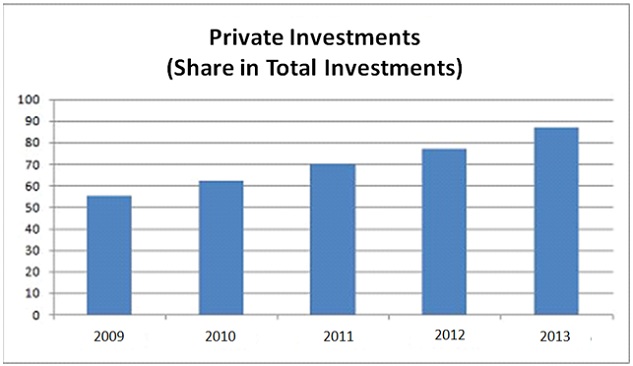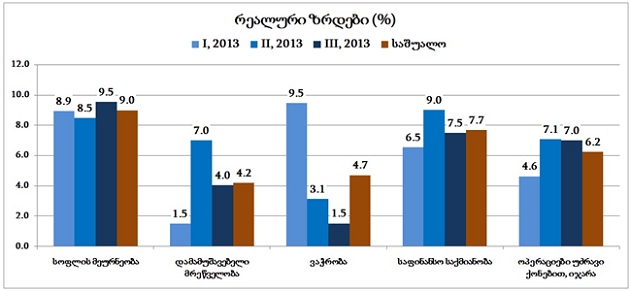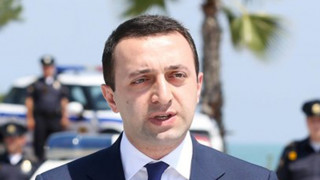Prime Minister Irakli Gharibashvili met with journalists at a press conference held on 16 January 2014. At the event, the Prime Minister spoke about the recovery of the economy. As stated by Gharibashvili: “Unlike in previous years, in 2013, the private sector played the predominant role in the economy. The indicator of real growth in agriculture stands at 9%. Financial intermediation grew by 7.6%, renting and real estate activities – by 6.3%, manufacturing and trade – by 4.5%.”
FactCheck took interest in the Prime Minister’s statement and checked its accuracy.
The state economy primarily relies on the private sector and, therefore, it naturally plays the leading role in the economy. Obviously, in 2013, equally as in previous years, the private sector played a predominant role in the economy.
FactCheck logically presumed that the Prime Minister was referring to the diminished contribution of the state in the gross fixed capital formation (total volume of investments made in the country). We inquired if the dominant position in the state economy in 2013 was held by the government or private investments. In the course of our query we analysed the statistical data on the acquisition of non-financial assets and gross fixed capital formation.
In line with the data of nine months (January-September) in the consolidated budget the acquisition of non-financial assets (which represents the investments made in the country by the government) amounted to GEL 544.5 million. According to the data provided by the National Statistics Office of Georgia, the gross fixed capital formation in the first three quarters of 2013 equalled GEL 193 million. Accordingly, in 2013 (based upon the data of three quarters) the share of government investments in the total volume of investments made in the country equalled 13%.
In 2012 the acquisition of non-financial assets totalled GEL 1.498 billion while the gross fixed capital formation amounted to GEL 6.496 billion. It can be deduced from these figures that in 2012 the share of government investments in the volume of total investments in the country equalled approximately 23%.
In 2011 the acquisition of non-financial assets reached GEL 1.675 billion while the gross fixed capital formation totalled GEL 5.474 billion. Consequently, in 2011 the share of government investments in the total pool of investments added up to 30%.
In 2010 government investments accounted for 38% of total investments while in 2009 the indicator stood at 45%.
As can be gathered from the figures shown above, in 2013 the share of government investments in the entire pool of investments saw a decrease and, correspondingly, an upturn was observed in the share of private investments.
 It is worthwhile noting that the volume of private investments notably exceeded that of government investments in the previous years as well. Additionally, the trend witnessed in the period 2009-2012 shows a tendency of decrease in the share of government investments (decrease in the percentage as well as the numerical sum). This process saw due continuation in 2013.
The Prime Minister also discusses the indicators of real growth witnessed in various sectors in 2013. It should be noted that the data for all four quarters of 2013 is yet to be published. Therefore, we verified the accuracy of the numbers indicated by the Prime Minister based upon the data of the first three quarters of 2013.
In accordance with the (preliminary) data of the first three quarters of 2013 provided by the National Statistics Office of Georgia, the real growth in the agricultural sector amounted to 9%. Financial intermediation saw an increase of 7.6%. Renting, real estate and business activities grew by 6.2%. The real growth indicator for manufacturing equalled 4.1% while wholesale and retail trade, and repair of motor vehicles, motorcycles and personal and household goods increased by 4.7%. Accordingly, the data of the first three quarters comes in agreement with the figures indicated by the Prime Minister.
It is worthwhile noting that the volume of private investments notably exceeded that of government investments in the previous years as well. Additionally, the trend witnessed in the period 2009-2012 shows a tendency of decrease in the share of government investments (decrease in the percentage as well as the numerical sum). This process saw due continuation in 2013.
The Prime Minister also discusses the indicators of real growth witnessed in various sectors in 2013. It should be noted that the data for all four quarters of 2013 is yet to be published. Therefore, we verified the accuracy of the numbers indicated by the Prime Minister based upon the data of the first three quarters of 2013.
In accordance with the (preliminary) data of the first three quarters of 2013 provided by the National Statistics Office of Georgia, the real growth in the agricultural sector amounted to 9%. Financial intermediation saw an increase of 7.6%. Renting, real estate and business activities grew by 6.2%. The real growth indicator for manufacturing equalled 4.1% while wholesale and retail trade, and repair of motor vehicles, motorcycles and personal and household goods increased by 4.7%. Accordingly, the data of the first three quarters comes in agreement with the figures indicated by the Prime Minister.
 Conclusion
In the first part of his statement, Prime Minister Irakli Gharibashvili notes that: “Unlike in previous years, in 2013, the private sector played the predominant role in the economy.” This formulation of the statement is misleading given the widely known fact that the state economy is primarily relying on the private sector; therefore, naturally, the private sector plays a predominant role in it. We made a logical assumption that the Prime Minister was referring to the diminished contribution of the state in the gross fixed capital formation (total volume of investments made in the country). Throughout our research we verified this fact as well. In 2013, as compared to the preceding year, the numerical volume of the government investments as well as its percentage in the entire pool of investments made in the country saw a notable downturn. However, the data of the last years reveals a stable tendency of decrease in the government investments and this trend persisted throughout the year 2013. In general, private investments always play the major role in the development of the economy; therefore, this part of the Prime Minister’s statement is incorrect.
As for the second part of the PM’s statement, pursuant to the data of the first three quarters of 2013, the indicator of real growth in agriculture equalled – 9%, in financial intermediation – 7.6%, renting, real estate and business activities – 6.2%, manufacturing – 4.1% and trade – 4.7%.
FactCheck concludes that Irakli Gharibashvili’s statement: “Unlike in previous years, in 2013, the private sector played the predominant role in the economy. The indicator of real growth in agriculture stands at 9%. Financial intermediation grew by 7.6%, renting and real estate activities – by 6.3%, manufacturing and trade – by 4.5%,” is HALF TRUE.
Conclusion
In the first part of his statement, Prime Minister Irakli Gharibashvili notes that: “Unlike in previous years, in 2013, the private sector played the predominant role in the economy.” This formulation of the statement is misleading given the widely known fact that the state economy is primarily relying on the private sector; therefore, naturally, the private sector plays a predominant role in it. We made a logical assumption that the Prime Minister was referring to the diminished contribution of the state in the gross fixed capital formation (total volume of investments made in the country). Throughout our research we verified this fact as well. In 2013, as compared to the preceding year, the numerical volume of the government investments as well as its percentage in the entire pool of investments made in the country saw a notable downturn. However, the data of the last years reveals a stable tendency of decrease in the government investments and this trend persisted throughout the year 2013. In general, private investments always play the major role in the development of the economy; therefore, this part of the Prime Minister’s statement is incorrect.
As for the second part of the PM’s statement, pursuant to the data of the first three quarters of 2013, the indicator of real growth in agriculture equalled – 9%, in financial intermediation – 7.6%, renting, real estate and business activities – 6.2%, manufacturing – 4.1% and trade – 4.7%.
FactCheck concludes that Irakli Gharibashvili’s statement: “Unlike in previous years, in 2013, the private sector played the predominant role in the economy. The indicator of real growth in agriculture stands at 9%. Financial intermediation grew by 7.6%, renting and real estate activities – by 6.3%, manufacturing and trade – by 4.5%,” is HALF TRUE.
 It is worthwhile noting that the volume of private investments notably exceeded that of government investments in the previous years as well. Additionally, the trend witnessed in the period 2009-2012 shows a tendency of decrease in the share of government investments (decrease in the percentage as well as the numerical sum). This process saw due continuation in 2013.
The Prime Minister also discusses the indicators of real growth witnessed in various sectors in 2013. It should be noted that the data for all four quarters of 2013 is yet to be published. Therefore, we verified the accuracy of the numbers indicated by the Prime Minister based upon the data of the first three quarters of 2013.
In accordance with the (preliminary) data of the first three quarters of 2013 provided by the National Statistics Office of Georgia, the real growth in the agricultural sector amounted to 9%. Financial intermediation saw an increase of 7.6%. Renting, real estate and business activities grew by 6.2%. The real growth indicator for manufacturing equalled 4.1% while wholesale and retail trade, and repair of motor vehicles, motorcycles and personal and household goods increased by 4.7%. Accordingly, the data of the first three quarters comes in agreement with the figures indicated by the Prime Minister.
It is worthwhile noting that the volume of private investments notably exceeded that of government investments in the previous years as well. Additionally, the trend witnessed in the period 2009-2012 shows a tendency of decrease in the share of government investments (decrease in the percentage as well as the numerical sum). This process saw due continuation in 2013.
The Prime Minister also discusses the indicators of real growth witnessed in various sectors in 2013. It should be noted that the data for all four quarters of 2013 is yet to be published. Therefore, we verified the accuracy of the numbers indicated by the Prime Minister based upon the data of the first three quarters of 2013.
In accordance with the (preliminary) data of the first three quarters of 2013 provided by the National Statistics Office of Georgia, the real growth in the agricultural sector amounted to 9%. Financial intermediation saw an increase of 7.6%. Renting, real estate and business activities grew by 6.2%. The real growth indicator for manufacturing equalled 4.1% while wholesale and retail trade, and repair of motor vehicles, motorcycles and personal and household goods increased by 4.7%. Accordingly, the data of the first three quarters comes in agreement with the figures indicated by the Prime Minister.
 Conclusion
In the first part of his statement, Prime Minister Irakli Gharibashvili notes that: “Unlike in previous years, in 2013, the private sector played the predominant role in the economy.” This formulation of the statement is misleading given the widely known fact that the state economy is primarily relying on the private sector; therefore, naturally, the private sector plays a predominant role in it. We made a logical assumption that the Prime Minister was referring to the diminished contribution of the state in the gross fixed capital formation (total volume of investments made in the country). Throughout our research we verified this fact as well. In 2013, as compared to the preceding year, the numerical volume of the government investments as well as its percentage in the entire pool of investments made in the country saw a notable downturn. However, the data of the last years reveals a stable tendency of decrease in the government investments and this trend persisted throughout the year 2013. In general, private investments always play the major role in the development of the economy; therefore, this part of the Prime Minister’s statement is incorrect.
As for the second part of the PM’s statement, pursuant to the data of the first three quarters of 2013, the indicator of real growth in agriculture equalled – 9%, in financial intermediation – 7.6%, renting, real estate and business activities – 6.2%, manufacturing – 4.1% and trade – 4.7%.
FactCheck concludes that Irakli Gharibashvili’s statement: “Unlike in previous years, in 2013, the private sector played the predominant role in the economy. The indicator of real growth in agriculture stands at 9%. Financial intermediation grew by 7.6%, renting and real estate activities – by 6.3%, manufacturing and trade – by 4.5%,” is HALF TRUE.
Conclusion
In the first part of his statement, Prime Minister Irakli Gharibashvili notes that: “Unlike in previous years, in 2013, the private sector played the predominant role in the economy.” This formulation of the statement is misleading given the widely known fact that the state economy is primarily relying on the private sector; therefore, naturally, the private sector plays a predominant role in it. We made a logical assumption that the Prime Minister was referring to the diminished contribution of the state in the gross fixed capital formation (total volume of investments made in the country). Throughout our research we verified this fact as well. In 2013, as compared to the preceding year, the numerical volume of the government investments as well as its percentage in the entire pool of investments made in the country saw a notable downturn. However, the data of the last years reveals a stable tendency of decrease in the government investments and this trend persisted throughout the year 2013. In general, private investments always play the major role in the development of the economy; therefore, this part of the Prime Minister’s statement is incorrect.
As for the second part of the PM’s statement, pursuant to the data of the first three quarters of 2013, the indicator of real growth in agriculture equalled – 9%, in financial intermediation – 7.6%, renting, real estate and business activities – 6.2%, manufacturing – 4.1% and trade – 4.7%.
FactCheck concludes that Irakli Gharibashvili’s statement: “Unlike in previous years, in 2013, the private sector played the predominant role in the economy. The indicator of real growth in agriculture stands at 9%. Financial intermediation grew by 7.6%, renting and real estate activities – by 6.3%, manufacturing and trade – by 4.5%,” is HALF TRUE.








